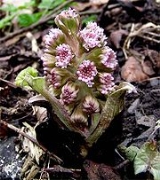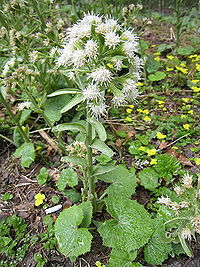
Butterbur
Encyclopedia
The plant
s commonly referred to as Butterbur are found in the daisy family Asteraceae
in the genus
Petasites. They are mostly quite robust plants with thick, creeping underground rhizome
s and large Rhubarb
-like leaves during the growing season. Another common name for many species of this genus is Sweet Coltsfoot.
s are produced just before the leaves in spring, emerging with only a few elongated basal bracts and are usually green, flesh coloured or dull white depending on species.
Butterburs are found in the temperate zone of the Northern Hemisphere
. They prefer moist environments such as riverbanks, marshes and ditches.
Petasites is very closely related to the genus Tussilago
(Coltsfoot), and also related to the huge genus Senecio
.
headaches. Several double-blind studies have shown that high doses of extracts of Petasites hybridus root, presumably containing petasin and/or isopetasin, are effective both in preventing and in relieving migraine, with the best results coming in more severe cases, but with gastrointestinal side effects. Additionally, a study showing Butterbur extract to be an effective treatment for hay fever without the sedative effect of the antihistamine cetirizine
.
Butterbur naturally contains components called pyrrolizidine alkaloids. They are toxic to the liver and may cause cancers. The concentrations are often highest in the rhizomes and stalks, and lowest in the leaves, and may vary depending on where the plants are grown. Butterbur extract should be taken only when prepared by a reputable laboratory. Long-term health effects and interaction with other drugs have not been studied.

Plant
Plants are living organisms belonging to the kingdom Plantae. Precise definitions of the kingdom vary, but as the term is used here, plants include familiar organisms such as trees, flowers, herbs, bushes, grasses, vines, ferns, mosses, and green algae. The group is also called green plants or...
s commonly referred to as Butterbur are found in the daisy family Asteraceae
Asteraceae
The Asteraceae or Compositae , is an exceedingly large and widespread family of vascular plants. The group has more than 22,750 currently accepted species, spread across 1620 genera and 12 subfamilies...
in the genus
Genus
In biology, a genus is a low-level taxonomic rank used in the biological classification of living and fossil organisms, which is an example of definition by genus and differentia...
Petasites. They are mostly quite robust plants with thick, creeping underground rhizome
Rhizome
In botany and dendrology, a rhizome is a characteristically horizontal stem of a plant that is usually found underground, often sending out roots and shoots from its nodes...
s and large Rhubarb
Rhubarb
Rhubarb is a group of plants that belong to the genus Rheum in the family Polygonaceae. They are herbaceous perennial plants growing from short, thick rhizomes. They have large leaves that are somewhat triangular-shaped with long fleshy petioles...
-like leaves during the growing season. Another common name for many species of this genus is Sweet Coltsfoot.
Characteristics
The short spikes of flowerFlower
A flower, sometimes known as a bloom or blossom, is the reproductive structure found in flowering plants . The biological function of a flower is to effect reproduction, usually by providing a mechanism for the union of sperm with eggs...
s are produced just before the leaves in spring, emerging with only a few elongated basal bracts and are usually green, flesh coloured or dull white depending on species.
Butterburs are found in the temperate zone of the Northern Hemisphere
Northern Hemisphere
The Northern Hemisphere is the half of a planet that is north of its equator—the word hemisphere literally means “half sphere”. It is also that half of the celestial sphere north of the celestial equator...
. They prefer moist environments such as riverbanks, marshes and ditches.
Petasites is very closely related to the genus Tussilago
Coltsfoot
Tussilago farfara, commonly known as Coltsfoot, is a plant in the family Asteraceae.It has been used medicinally as a cough suppressant. The name "tussilago" itself means "cough suppressant." The plant has been used historically to treat lung ailments such as asthma as well as various coughs by way...
(Coltsfoot), and also related to the huge genus Senecio
Senecio
Senecio is a genus of the daisy family that includes ragworts and groundsels. The flower heads are normally rayed, completely yellow, and the heads are borne in branched clusters...
.
Medicinal uses
Butterbur was used by native Americans as a remedy for headache and inflammation. Some Butterbur species contain the chemicals petasin and isopetasin which are believed to have potential benefits in treating headache. The highest concentrations occur in Butterbur root. Butterbur root extracts have been reported to be effective in reducing the occurrence or severity of migraineMigraine
Migraine is a chronic neurological disorder characterized by moderate to severe headaches, and nausea...
headaches. Several double-blind studies have shown that high doses of extracts of Petasites hybridus root, presumably containing petasin and/or isopetasin, are effective both in preventing and in relieving migraine, with the best results coming in more severe cases, but with gastrointestinal side effects. Additionally, a study showing Butterbur extract to be an effective treatment for hay fever without the sedative effect of the antihistamine cetirizine
Cetirizine
Cetirizine , a second-generation antihistamine, is a major metabolite of hydroxyzine, and a racemic selective H1 receptor inverse agonist used in the treatment of allergies, hay fever, angioedema, and urticaria.-Availability:...
.
Butterbur naturally contains components called pyrrolizidine alkaloids. They are toxic to the liver and may cause cancers. The concentrations are often highest in the rhizomes and stalks, and lowest in the leaves, and may vary depending on where the plants are grown. Butterbur extract should be taken only when prepared by a reputable laboratory. Long-term health effects and interaction with other drugs have not been studied.
Selected species

- Petasites albusPetasites albusPetasites albus is a plant species in the genus Petasites commonly referred to as White Butterbur....
White Butterbur - Petasites amplus
- Petasites doerfleri
- Petasites formosanus
- Petasites fragransPetasites fragransPetasites fragrans is an medicinal plant and ornamental plant....
Winter Heliotrope - Petasites frigidusPetasites frigidusPetasites frigidus is a species of Petasites native to Arctic to cool temperate regions of the Northern Hemisphere in northern Europe, northern Asia and northern North America.It is a herbaceous perennial plant producing flowering stems in early spring, and large leaves through the summer...
(syn. P. speciosa) Arctic Butterbur or Arctic Sweet Coltsfoot - Petasites hybridus Common Butterbur
- Petasites japonicus Giant Butterbur, or Fuki
- Petasites kablikianus
- Petasites paradoxus
- Petasites radiatus
- Petasites sagittatus
- Petasites sibiricus
- Petasites speciosa
- Petasites spuriusPetasites spuriusPetasites spurius is a flowering plant of the genus Petasites in the family Asteraceae....
- Petasites tatewakianus
- Petasites tricholobus
External links
- Flora Europaea: Petasites species list and distributions
- eFloras search results: Petasites
- Edibility of Petasites: Visual identification and edible plarts of sweet coltsfoot.

